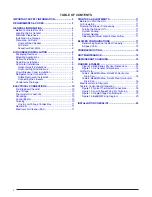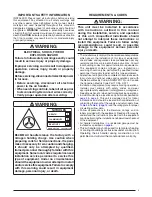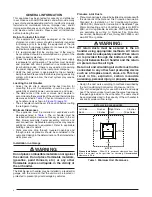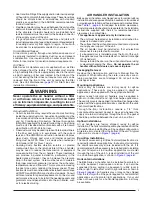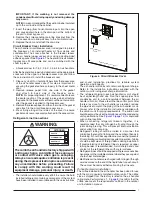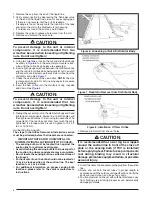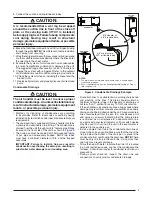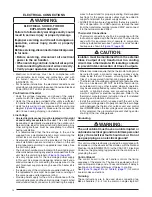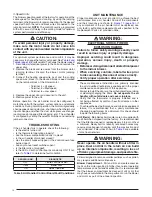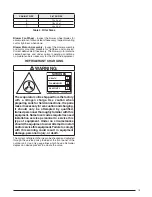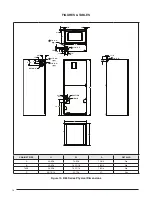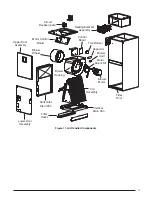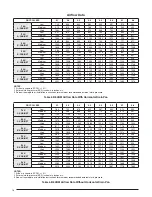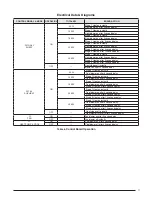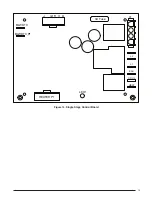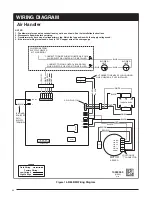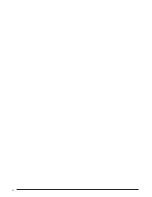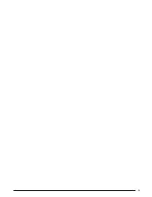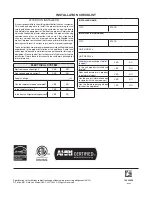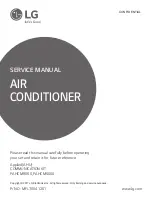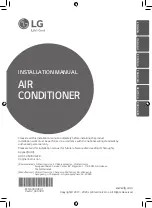
12
3-Speed Units
The blower speed is preset at the factory for operation at the
same speed for heating and cooling, by using the jumping
terminal on the blower motor and connecting it to the desired
speed with both the red and black wires connected to the
jumping terminal.
NOTE:
The control board is programmed
with a 40 second off delay in the cooling mode for optimum
system performance and efficiency.
CAUTION:
To avoid personal injury or property damage,
make sure the motor leads do not come into
contact with any uninsulated metal components
of the unit.
For optimum system performance and comfort, it may be
necessary to change the factory set speed. See
for airflow data. To change the blower speed:
1. Disconnect all electrical power to the unit and remove the
upper door.
2. Remove the black and red wires from the blower motor
jumping terminal. Discard the blower motor jumping
terminal.
3. Connect the heating speed wire (red) and the cooling
speed wire (black) to the desired blower speed marked
on the terminal block of the blower motor.
• Terminal 4 = Hi speed
• Terminal 5 = Med speed
• Terminal 6 = Low speed
4. Replace the upper door and secure it to the unit.
5. Restore power to the unit.
Before operation, the air handler must be configured to
match the unit with the system, system options, and climatic
conditions. During normal operation, the motor will gradually
change speeds during start-up, shut down, when thermostat
inputs change, and when the duct static pressure changes
(vents closed or opened, filter clogging, etc.). The air handler
is configured by setting the selector switches and removing
jumper connectors.
TROUBLESHOOTING
If the air handler fails to operate, check the following:
• Is the electric turned on?
• Is the thermostat operating properly?
• Are the blower compartment door(s) in place?
• Is the air handler disconnect closed?
• Has the circuit breaker tripped or the control board fuse
burned open?
• Are any manual reset switches open?
• Is the filter dirty or plugged?
• Is the LED on both control boards constantly ON? If not,
refer to
to determine fault condition.
UNIT MAINTENANCE
Proper maintenance is most important to achieve the best
performance from a air handler. Some of the components
and their locations are shown in
. If
any component of the air handler must be replaced, use
only factory authorized replacement parts specified in the
Replacement Parts List provided online.
WARNING:
ELECTRICAL SHOCK, FIRE OR
EXPLOSION HAZARD
Failure to follow safety warnings exactly could
result in serious injury or property damage.
Improper servicing could result in dangerous
operation, serious injury, death or property
damage.
• Before servicing, disconnect all electrical power
to the indoor blower.
• When servicing controls, label all wires prior
to disconnecting. Reconnect wires correctly.
• Verify proper operation after servicing.
• These maintenance instructions are primarily intended
to assist qualified technicians experienced in the proper
maintenance and operation of this appliance.
• Always reinstall the doors on the air handler after servicing
or cleaning/changing the filters.
Do not operate the air
handler without all doors and covers in place.
• Verify that the thermostat is properly installed and is
not being affected by drafts or heat from lamps or other
appliances.
• To achieve the best performance and minimize equipment
failure, it is recommended that a yearly maintenance
checkup be performed. At a minimum, this check should
include the following items:
Air Filter(s)
- B64 Series Air Handlers are not supplied with
a air filter when shipped from the factory. It is recommended
that the filter be cleaned or replaced every 4 to 6 months at
a minimum. Newly built or recently renovated homes may
require more frequent changing until the construction dust
has minimized. Filter sizes shown in
at most local retailers.
WARNING:
Never operate the air handler without a filter in
place. Dust and lint in the return air can build
up on internal components, resulting in loss of
efficiency, equipment damage, and possible fire.
Filters designed to remove smaller particles such as pollen,
may require additional maintenance.
Blower Compartment
- Dirt and lint can create excessive
loads on the motor resulting in higher than normal operating
temperatures and shortened service life. It is recommended
that the blower compartment be cleaned of dirt or lint that
may have accumulated in the compartment or on the blower
and motor as part of the annual inspection.
RED LED (AN2)
DIAGNOSTIC
OFF
Control Fault (No Power)
Flash
Blower Fault
ON
Normal Operation
Table 2.
Air Handler Control Board Fault Conditions


